Student's training assures safe drinking water for campus
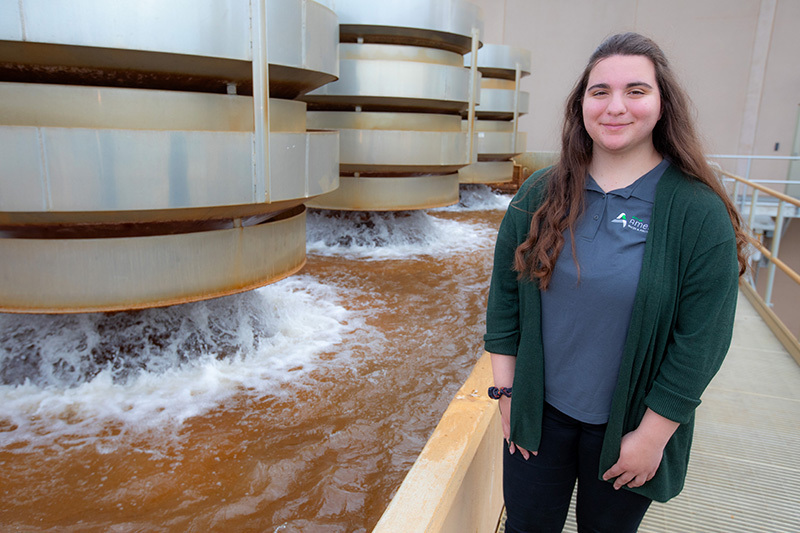
Environmental engineering graduate student Daria Dilparic works at the Ames Water Plant to monitor forever chemicals in the city's water. Photo by Christopher Gannon.
What started as a weekend job for Daria Dilparic turned into a key role in ensuring the safety of Ames drinking water -- the provider of water to campus.
Questions?
For more information about Ames' drinking water, call the water plant at
239-5150.
"Originally, my project was to look at how PFAS transform in wastewater across plants in Iowa," she said. "When my professors found out I was already working for the city, they wanted me to do a project with the department."
For about a year, the environmental engineering graduate student has been sampling water from each of the city's 22 wells looking for Per- and Polyfluoroalkyl Substances (PFAS) -- commonly called forever chemicals. She wants to determine how prevalent they are in the water and how the contamination enters the water source.
Results
Consistent testing for forever chemicals in drinking water allowed the Ames Water Plant to comply with proposed federal standards (see chart) of maximum allowable levels of the chemicals.
On March 14, the Environmental Protection Agency (EPA) proposed national primary drinking water regulations for six PFAS chemicals. Levels for two of the forever chemicals were set at less than 4.0 parts per trillion, and Ames recorded marks of zero and 1.36 parts per trillion in 2022.
The proposal is in a public comment period until May 30 and could be finalized by the end of the year. EPA leaders said adopting the regulations would prevent thousands of deaths and reduce serious PFAS-related illnesses -- like liver disease, thyroid disease and cancer -- by tens of thousands.
"In December 2021, the Iowa Department of Natural Resources tested four of our wells and found an elevated level of PFAS in one of them," said Ames water and pollution control department assistant director Lyle Hammes. "That led to required testing on a quarterly basis. We then tested all of our wells and discontinued using the well with the highest level of PFAS."
The city's water service draws water from wells drilled into an alluvial aquifer under the city and serves Iowa State and those within the Ames corporate limits. Testing at the wells helps identify issues before water reaches the water plant and becomes much more costly to remove, Hammes said.
Impact
Dilparic splits work time between collecting samples and analyzing water using liquid chromatography-mass spectrometry -- the process to identify PFAS in water. Iowa State owns the highly sophisticated equipment needed to do this, and she is one of four students in the civil, construction and environmental engineering department capable of operating it.
"We visited one of the demo labs of the company we bought it from and they taught us about the equipment -- basic maintenance and operation," she said. "When we got it set up, they sent out a representative and technician to help guide us."
Dilparic's ability to use the equipment benefits the water plant because most cities have to send samples to an EPA-certified lab to complete the tests.
Tracking the level of compounds in each well gives water plant staff a better idea of water quality by the time it reaches the plant. Dilparic said regulations for forever chemicals in drinking water would be a step forward for the nation's water supply.
"If the maximum contaminant levels are set, it would impact every water utility, because current health advisories are not enforceable," she said. "Just like with all contaminants, there is a path forward with PFAS."
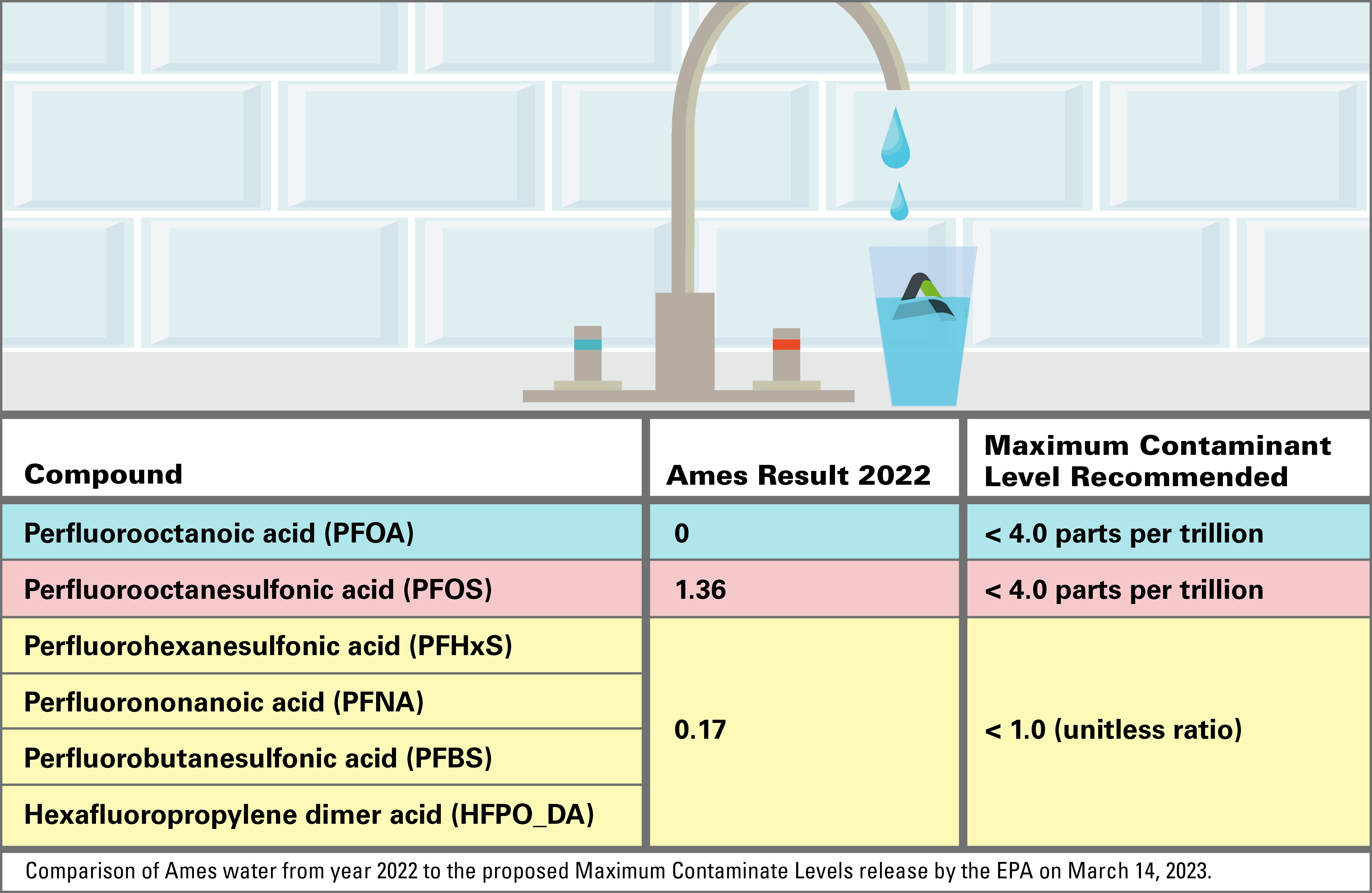
Graphic by Deb Berger.
Related essay
- Daria Dilparic writes about her experiences as an Iowa State student and student operator for the city, Nov. 4, 2022
New parking system adds credit card payment, license plate 'virtual' permits
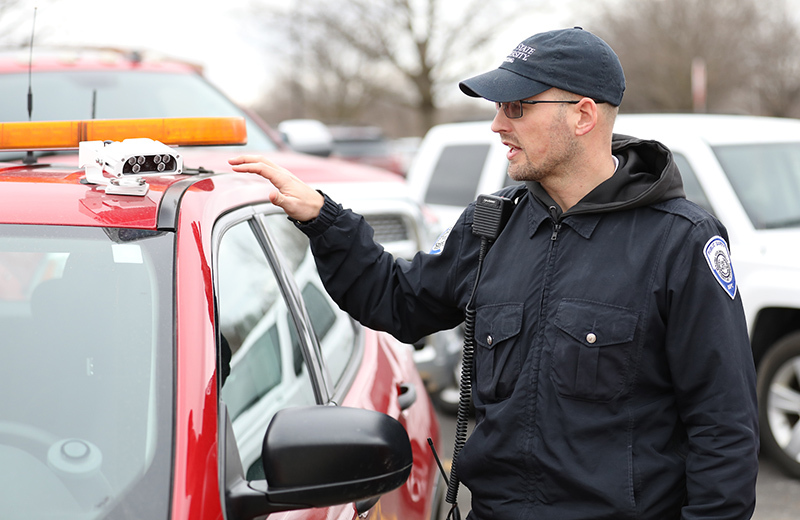
Aaron Steffen, parking enforcement supervisor, explains how the license plate-recognition cameras mounted on the roof of parking vehicles will make permit enforcement more efficient for his team. Photo by Christopher Gannon.
Starting this summer, faculty and staff will be able to purchase a "virtual" parking permit and pay citations through an online portal. The portal is part of a system upgrade the parking division made to improve efficiencies in its operations and provide convenience for customers. With a few exceptions, vehicle hangtags for the rearview mirror will go away, replaced by license plates.
"The days of moving a permit between your personal vehicles, or appealing a 'no permit' citation are gone," said parking director Mark Miller. "We think faculty, staff and students will find our new system flexible and easy to use year-round, not just at renewal time."
Online service
In May, permit holders will receive an email from the parking division containing a link to the new portal on the parking division website. The permit holder's name, university ID, and office address will be shown. Employees need to confirm or update their contact information and provide up to five valid license plates to be associated with that permit for the fiscal year that begins July 1. The virtual permits available for purchase will display on the permit page.
Learn more
FAQ on using the new ISU parking portal
Payroll deduction will remain a payment option for permits. The new system accepts credit cards, but paying through a U-Bill no longer will be an option for parking permits. A follow-up email from parking will confirm permit holders completed the process and have purchased a "virtual" permit.
Fines associated with parking tickets -- both permit holders and campus visitors -- also can be paid on the portal (within 30 days), and permit holders can update their vehicle and license plate information at any time.
Parking permit holders who leave the university will simply send an email to parking@iastate.edu and their permit will be canceled that day; there's no need to turn in a hangtag to cancel a permit.
New technology: license plate recognition
Miller said many large public universities are switching to license plate recognition in lieu of hangtag or sticker permits. The technology provides greater flexibility to permit holders, but it also achieves cost savings and adds efficiency to the process of patrolling parking lots. Iowa State's system will involve license-plate scanning cameras mounted on parking vehicles that can read hundreds of license plates in the time it takes to drive through a lot. All of the data is processed immediately in a cloud-based system, flagging vehicles that either aren't registered in ISU's parking system or don't have a virtual permit for that lot.
The system also alerts parking officers if two vehicles registered to the same permit are parked on campus within a two-hour window. Spouses and domestic partners who have registered the same vehicles on separate permits don't trigger this alert. However, the system won't allow a permit holder to register a vehicle already assigned to another permit, so parking staff will need to link the two permits. One of the spouses/partners should call (515-294-3388) or email the parking office to designate which vehicles are primary and secondary on each permit.
Miller said the new system will save his staff time beyond just patrolling lots. For example, last year, there were 675 incidents of valid permit holders not displaying their permit and receiving a citation. Those instances cost administrative time to appeal and correct, he noted.
Three hangtags remain active
For any vehicle the system flags, Miller said his staff then checks for the presence of a hangtag before issuing a citation. Three types of hangtags will remain in use on campus: Medical, vendor and departmental. Medical permit renewals can be purchased through the new portal. New medical permit requests will need to be processed at the parking office since the permit requires a valid DOT medical placard.
Departmental permits, nearly all of which are purchased with a Worktag or grant number, still must be purchased on the parking division website. Miller noted that departmental permits also tend to be shared among a team of employees, making it less likely all relevant vehicles are registered with the permit. Vendors also will continue to purchase their permits on the parking division website.
Visitors to campus
As is the case now, visitors to campus are encouraged to arrange for parking in advance of their arrival. They will have the option to register their license plate through the portal or print a dashboard permit (as they do now). Visitors may park in general staff and student lots for $5 per day.
Benefits survey reveals satisfaction and suggestions
More than 90% of employees who responded said the benefits offered by Iowa State meet their needs, according to results from the benefits survey administered last fall.
Available Nov. 11-18, 2022, university human resources (UHR) collaborated with consulting firm Mercer to design and conduct the benefits survey in hopes of gaining insight into the overall perception of the university's benefits as well as employee concerns. The response rate was 42% with 2,780 faculty and staff completing the survey.
Feeling good
Seventy-eight percent of employees said they felt proud to work for ISU and 74% would recommend it as a great place to work and feel motivated to help the university succeed. Overall benefits satisfaction also was positive -- 86% of respondents agreed that the benefits are competitive with those in the geographic area, while 65% felt the benefits are competitive with other higher education institutions.
| Benefit | Iowa State satisfaction | US Norm (provided by Mercer) |
|---|---|---|
| Total benefits package | 88% | 76% |
| Medical plan out-of-pocket costs | 76% | 46% |
| University match for mandatory retirement options | 87% | 73% |
| Paid time off | 88% | 76% |
| Choice of medical plan options | 89% | N/A |
| Medical plan cost deductible | 79% | N/A |
Benefits play a significant role in attracting and retaining employees, particularly professional and scientific (P&S) and merit positions. Sixty-five percent of employees considered benefits as a factor when choosing to work at ISU -- of that total, 48% of faculty report benefits as an attraction factor. While 69% of faculty consider benefits when it comes to retention, more than 80% of P&S and merit employees indicate benefits as an important reason to stay.
Responses to the open-ended question "Which benefits most contribute to your satisfaction with ISU?" highlighted appreciation for the accessibility and affordability of health care, amount of vacation and sick time, work flexibility and retirement plans.
Ed Holland, UHR director of benefits, said it was gratifying to see the overall positive responses.
"The university invests a significant amount of money to provide a great benefits package," he said. "It's clear that employees notice."
Room to grow
The survey results also included feedback from employees detailing the potential for improvement in some areas. The primary concerns, in order of frequency, were work-life balance, job security, ability to retire and personal fulfillment. Planning for monthly expenses and mental/emotional health tied for fifth on the list. Top concerns varied by job family -- work-life balance was first for P&S employees and faculty, while planning for monthly expenses was prioritized by employees in merit positions.
Employees who provided comments for the question "What is one thing that could make ISU benefits better?" noted a desire for more advancement opportunities, competitive pay and recognition for high performers as well as improved vision and dental benefits.
While the results show room for growth in certain areas, Holland said it's to be expected and part of the reason why it's important to gauge employees' understanding and perceptions of the benefits program.
What's next
Next steps based on the 2022 survey are underway as UHR leaders identify possible initiatives and build out an action plan. Some items already are being addressed, such as those around the UHR benefits website. Though 77% of respondents felt they had a good understanding of their benefits, only half of respondents viewed the UHR benefits website as easy to navigate when looking for answers. Holland said UHR was in the process of introducing ALEX, the virtual benefits counselor shortly before the survey was administered and have since updated the benefits education page.
Similarly, support for parents emerged as a concern in the survey and resulted in parenting support resources being made available through Adventure2 in January. Holland said they also anticipate releasing a suite of financial well-being services in Adventure2 in response to the survey data. There's more good news for those considering or already engaged with Adventure2 -- Holland noted that employees in Adventure2 consistently responded more positively throughout the survey.
"The results will continue to guide us as we review and consider our current benefit structure," Holland said. "Overall, it was overwhelmingly positive but this is why you do surveys -- to uncover areas where we can fine-tune our offerings."
Reminder: Strategic plan project proposals due April 28
Iowa State will fund a first round of annual projects that further bring to life the university's 2022-31 strategic plan. To be considered for funding for the fiscal year that begins July 1, faculty and staff must submit their project proposals by 5 p.m. Friday, April 28, via the strategic plan website. Senior advisor to the president Sophia Magill said decisions made by Iowa State's senior leadership team about funded proposals are anticipated by the end of June.
Proposals should align with one or more of the strategic plan's statements of aspiration and "have the potential to move Iowa State forward in transformational ways," she said.
What's in a submission?
A project proposal will include these components:
- Project title and executive summary
- Project leader
- Other team members (if applicable)
- Alignment with 'To Be' statements in the strategic plan
- Project goal(s) and objective(s), and the approach to achieving them
- Budget: resources template and narrative
- Impact, return on investment
- Success metrics
- Partnerships, whether internal or external
Where to find answers
An FAQ on the strategic plan website provides helpful information about the submittal process, and Magill provided additional information during a series of March campus forums and webinar (recording available in CyBox). Questions also may be sent via email (strategicinitiatives@iastate.edu) or phone (294-2042) to Magill. Requestors are advised to review the online proposal form in advance and be prepared to complete it in one sitting; the system doesn't save partial entries.
Related story
Search launches for next LAS dean
Iowa State has launched the search for its next dean of the College of Liberal Arts and Sciences (LAS). The successful candidate will succeed Beate Schmittmann, who last month announced her retirement at the end of the 2023-24 academic year.
The search process will begin with the nomination of high-quality candidates, followed by a review of applications, and interviews with semifinalist and finalist candidates. Parker Executive Search will assist the committee throughout the process.
"The dean of Liberal Arts and Sciences is a critical, high-profile position that impacts every student on campus," said senior vice president and provost Jonathan Wickert. "We are looking for a visionary leader who will build on Dean Schmittmann's work over the last 10 years and take the college to even higher levels."
Sam Easterling, James and Katherine Melsa Dean of Engineering; and Dawn Bratsch-Prince, associate provost for faculty; will co-chair the search. Other members of the search committee are:
- Tunde Adeleke, University Professor, history
- Amy Andreotti, University Professor, Roy J. Carver Department of Biochemistry, Biophysics, and Molecular Biology
- Steve Butler, Morrill Professor, mathematics
- Brad Dell, associate professor and chair, music and theatre
- Tracy Lucht, associate professor, Greenlee School of Journalism and Communication
- Jennifer Owens, director, LAS student services
- David Peterson, professor, political science, and chair of the Faculty Senate LAS caucus
- Judy Ralston-Hansen, LAS Dean's advisory committee
- Donald Sakaguchi, Morrill Professor, genetics, development and cell biology
- Karen Scheel, teaching professor, psychology
- Matthew Sivils, professor, English, and director of the Center for Excellence in the Arts and Humanities
- Levi Stanley, associate professor, chemistry, and chair of the LAS representative assembly
- Julie Wilhelm, associate teaching professor, world languages and cultures
- Zhengyuan Zhu, professor, statistics, and director of the Center for Survey Statistics and Methodology
Representatives from Student Government and the Graduate and Professional Student Senate will be added to the committee in the coming weeks.
Members of the campus community are encouraged to submit nominations of talented candidates to any member of the search committee.
Englin retires next month; Speight named interim residence director
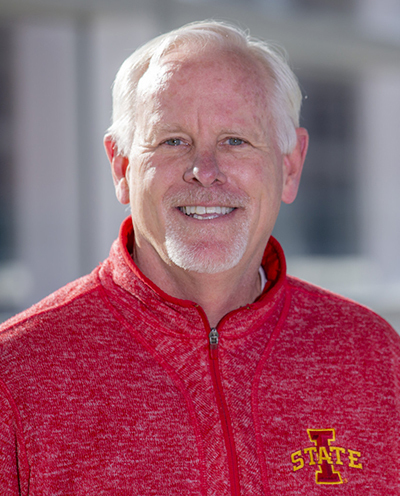
Englin
Associate vice president for campus life and director of residence Pete Englin will retire from Iowa State on May 1 after nearly 35 years of service in Iowa State's student affairs division. Director of residence life and conference services Virginia Speight ("Spate") will begin serving as interim associate vice president and residence director on May 2.
Also retiring is administrative assistant Chris Patton, who has worked with Englin since 1999, the last 18 years in the residence director's office.
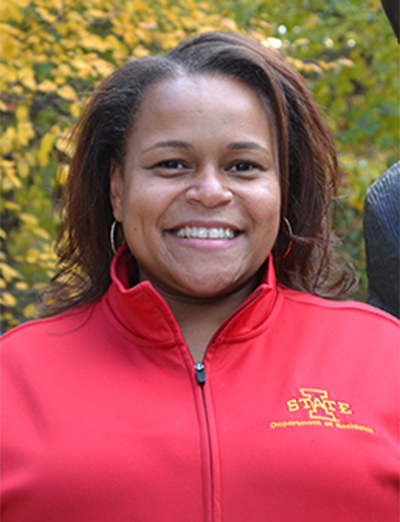
Speight
A national search has begun, with the goal of welcoming Englin's successor by the start of fall semester. Associate vice president for student health and wellness Erin Baldwin, who also leads the Thielen Student Health Center, is chairing the six-member committee. The Spelman Johnson executive search firm is assisting with the search.
The associate vice president for campus life leads three units -- department of residence, ISU Dining and the Memorial Union -- and two broad functions for the division of student affairs, capital and facilities planning, and strategic planning.
Rollout of Workday Student and Receivables begins soon
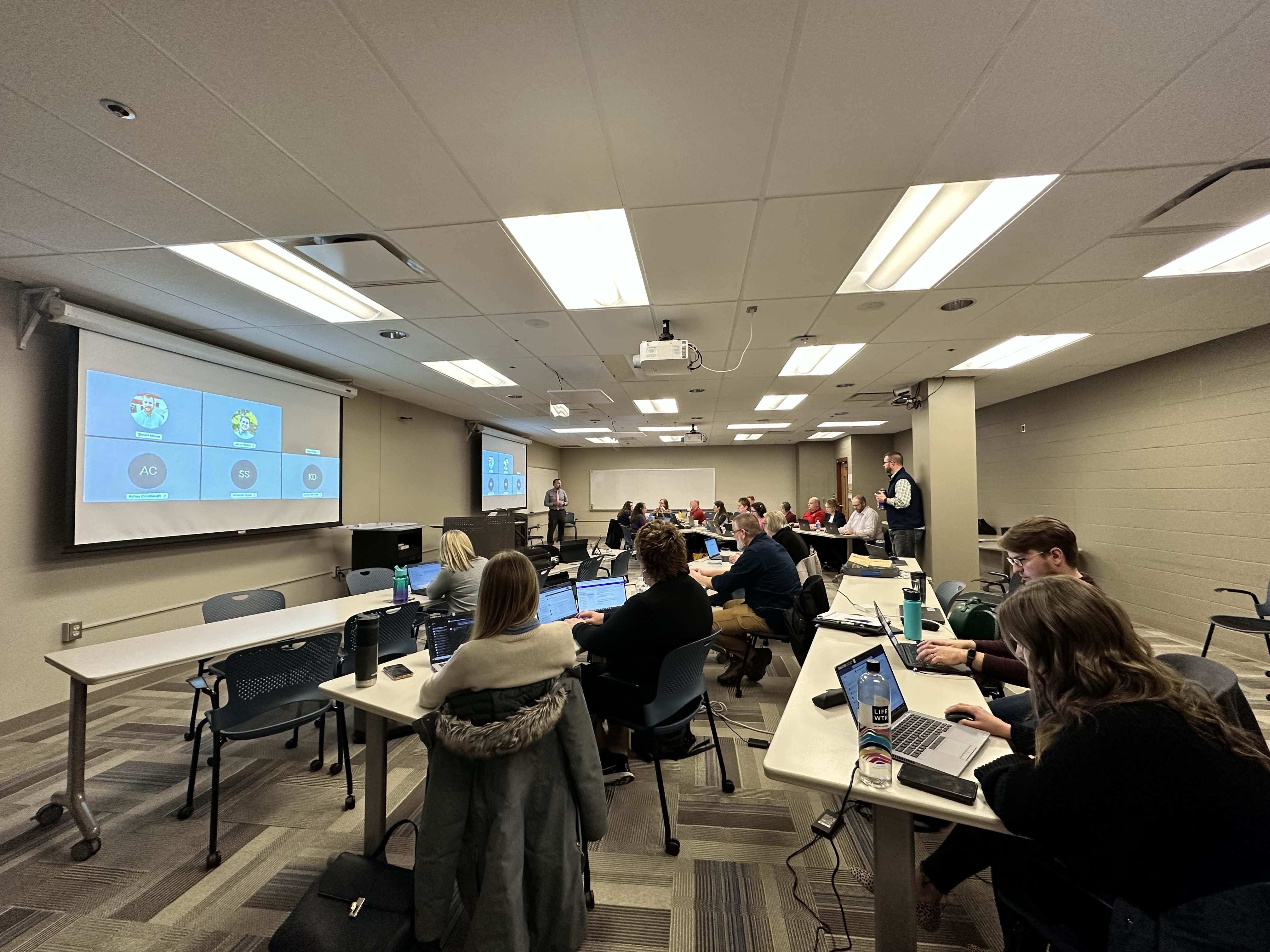
WorkCyte team members at an early April meeting to discuss testing and training for the WorkCyte Phase II: Student Information and Receivables project. Photos by Carly Hanson.
The first of six rollouts for the WorkCyte Phase II: Student Information and Receivables project is coming soon. Slated for June to September, this rollout will transition key admissions and curricular processes to the Workday Student software.
Geoff Janes, one of the team leads for the WorkCyte program, said the ball will start rolling on June 15 when the application opens for undergraduate admission. The first rollout will impact external processes for incoming students and the employees -- primarily in admissions and financial aid -- who help them get started at Iowa State.
Applications for new students coming to Iowa State in fall 2024 will be the first processed in Workday Student. Current and incoming students for fall 2023, spring 2024 and summer 2024 will continue to be managed in the legacy systems that will be replaced by Workday Student in early 2024.
Janes said they've tried to make the transition as seamless as possible for students and employees alike even as the team members and campus community grapple with the scale of the project.
What is Workday?
Workday is a software product. Iowa State implemented Workday Human Capital Management and Finance software on July 1, 2019. Beginning in June 2023 and concluding Dec. 2024, the university will transition to using Workday Student and Receivables software for most student information needs, as well as modernizing the receivables process.
What is WorkCyte?
WorkCyte is the Iowa State program to modernize university-wide systems and software. There are more than 260 members on the team. Members of various campus units participate in the WorkCyte program, including university human resources, division of operations and finance, enrollment management and information technology services.
"Today, staff are logging into ADIN, Access Plus, DocFinity and other software to do things. The biggest win with Workday is that it's one system," said Janes. "We will still have integrations with Canvas, EAB Navigate and other tools but we're creating a path to use fewer, more modern systems so employees can do their jobs more effectively."
Rollout details
The first rollout also adds the ability to view experimental courses in the catalog, evaluate graduate program applicants and calculate financial aid in Workday, though the federal government's delay in releasing the Free Application for Federal Student Aid (FAFSA) from October to December may impact the Workday financial aid implementation timeline. The second rollout, which includes curriculum management and student financials, is scheduled to begin in October.
Janes and Crystal Johnson, another team lead for WorkCyte, commended the university community and WorkCyte project teams as they continue to bring Workday Student to life.
"Change is hard and we have to remind people that we feel it too," said Johnson. "We're one Iowa State University. We are here to support people and that's what will get us through -- the reminder that we aren't doing this alone."
Training will be provided in stages aligned with the implementation of the rollouts and will include knowledge base articles, video courses in Workday Learning and in-person and virtual instructor-led sessions. Units will be contacted when it's time for training.
Information about Workday Student and Receivables can be found on the WorkCyte website. Employees can subscribe to WorkCyte Digest, a monthly newsletter with program updates and information about upcoming training opportunities.
Phased implementation
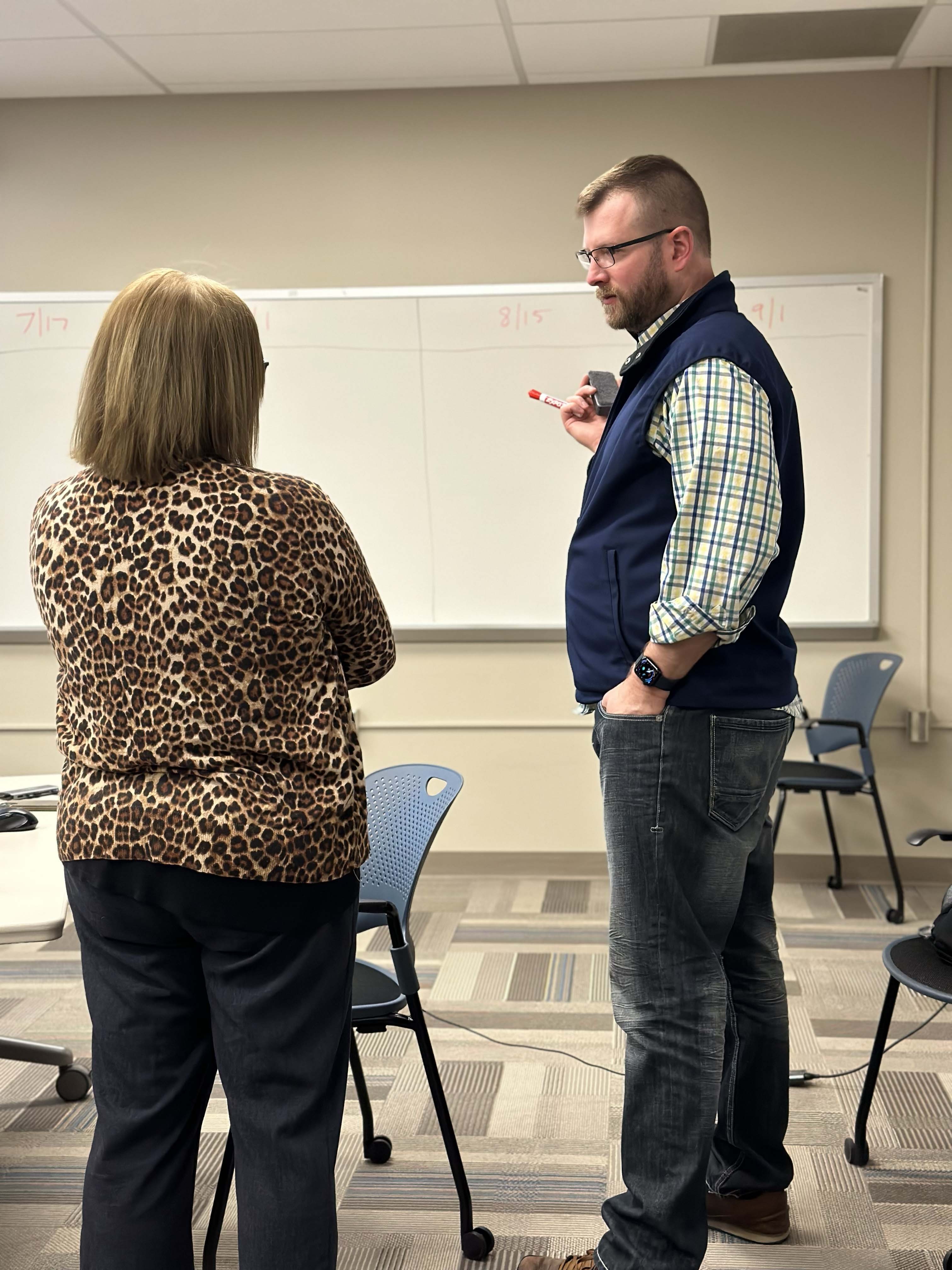
Team lead Steven Moore (r) says the team is currently working on testing for the second move to production in 2024 and estimates that they will exceed 12,000 scenarios due to the increased scope of this phase.
Johnson says everyone who does business at Iowa State eventually will be impacted by the Workday implementation project. With the phased implementation approach of Phase II, the WorkCyte teams hope to ease the university community and partners into the change.
"We've heard from colleagues about how the Phase I transition was a challenge for some areas of campus. As we go into Phase II, we are focusing on the importance of delivering training materials and acknowledging different methods of support to serve campus and our customers through this change," Johnson said.
Preparing for the rollouts and creating training materials requires testing -- and a lot of it. Janes said the teams ran through more than 11,500 scenarios during the planning process ahead of the June rollout. Scenarios explore the process of matriculation to degree conferral for hypothetical students -- for instance, a student from an Iowa high school majoring in engineering -- and help the teams set up milestones in the system that will guide employees with date controls and other parameters to make managing student processes more efficient.
Johnson said the teams behind the testing work as a think tank. As they craft scenarios, each person contributes their expertise, informed by their knowledge of the student life cycle and understanding of the needs of different campus units.
"The teams are spending hours building for the future of ISU," said Johnson. "We've spent a lot of time in the last two years meeting with campus partners asking how we can streamline so employees don't need to be technology experts to use the system."
Ongoing innovation
The WorkCyte program was established at the university in 2017. Janes noted that the last comparable enterprise software project was in the 1970s when ADIN was released, but the scale of the WorkCyte program far exceeds it. When Phase II wraps up, updates from Workday -- scheduled to be released twice a year -- will keep the university on the cutting edge.
"The one thing Iowa State has always done well and will continue to do is constantly improve," said Johnson. "Whenever I go to conferences, everyone wants to hear from Iowa State and know what we are doing."
In addition to being a much-needed upgrade, Janes said the implementation of Workday Student will create more transparency for students and employees.
"For a student, there will be much more visibility into their degree progess, making it easier to plan for future semesters," he said. "For employees, reporting will be better because data and information will be more accessible."
Norman shares his first 100 days with the senate
Senior vice president for operations and finance Shawn Norman detailed three areas of focus during his first 100 days on the job and goals moving forward for the division at the April 18 Faculty Senate meeting. Norman started at Iowa State on Jan. 1.
Norman told senators he hired Grant Thornton International to help him conduct an assessment of the division of operations and finance. The assessments three areas of focus:
- Operations: A review of resources and policies.
- Resource Management Model: Ensure the campus community knows what the budget model is and how it works. Norman said the aim is to simplify, not change, it.
- Communications: Develop a communication strategy to improve communication inside and outside the division.
Norman said the assessment will continue through June.
The operations and finance division features four units: budget, institutional financial strategy and treasury; finance services; facilities planning and management; and specialty business services and cultural arts.
Speech communication degree
Senators approved discontinuing the bachelor's degree in speech communication in the College of Liberal Arts and Sciences. The program graduated four students last spring. The English department will save more than $75,000 by eliminating 10 courses associated with the major.
Elections
The senate elected three council chairs who will be sworn in at the May meeting:
- Academic affairs: Jennifer Schieltz, natural resource ecology and management
- Faculty development and administrative relations: Brian Hornbuckle, agronomy
- Resource policies and allocations: Tim Bigelow, electrical and computer engineering
The Faculty Senate's final meeting of the semester is May 2.
